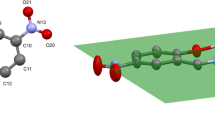A chain of new vanadium(IV) complexes of Schiff bases, derived from acetohydrazide (HL1-3) or 4-aminoantipyrine (HL4-7) have been prepared and physicochemically distinguished using different tools including analytical, spectral, and magnetic techniques. The spectral and analytical data showed that ligands HL1-3 acted as neutral bidentate ligands, chelated through hydrazono carbonyl and azomethine groups, whereas HL4 acted as neutral tetradentate ligand coordinated via pyrazolone carbonyl, NH group, hydrazono carbonyl, and azo (N=N) groups forming binuclear complexes. The HL5 and HL6 behave as neutral bidentate ligands coordinating through pyrazolone carbonyl and NH groups; in case of ligand HL6, in addition to the mentioned mode, C=N and CN groups participated to bind a second VO(II) ion form binuclear complexes. HL7 behaves as a monobasic bidentate ligand bonded via deprotonated OH and azomethine groups. All complexes adopt square pyramidal geometry around vanadium ion. Results revealed that the oral management of vanadium complexes significantly reduced the blood glucose level in rats suffered from diabetes. The correction of altered biochemical parameters via treatment with vanadium complexes points the improved glucose balance.






Similar content being viewed by others
References
V. Sabetsky and J. Ekblom, Pharmacol. Res., 61, 1 – 4 (2010).
American Diabetes Association: Diagnosis and Classification of Diabetes Mellitus, Diabetes Care., 33, S62 – S69 (2010).
Diabetes Mellitus: Reports of a WHO Study Group, WHO Technical Report Series, 727, 876 (1985).
B. Ramachandran, D. S. Sekar,M. Kandaswamy, et al., Exp. Diabetes Res, 5, 137 – 142 (2004).
B. Ramachandran, M. Kandaswamy, V. Narayanan, and S. Subramanian, Diabetes Obes. Metab., 5, 455 – 461 (2003).
B. Ramachandran, K. Ravi, V. Narayanan, et al., Clin. Chim. Acta, 345, 141 – 150 (2004).
B. Ramachandran, K. Ravi, V. Narayanan, et al., Chem. Biol. Interact, 149, 9 – 21 (2004).
H. K. Thompson and C. Orvig, J. Chem. Soc. Dalton Trans., 2885 – 2892 (2000).
H. Sakurai, H. Sano, T. Takino, and H. Yasui, J. Inorg. Biochem., 80, 99 – 105 (2000).
C. E. Heyliger, A. G. Tahiliani, and J. H. Mcneill, Science, 227, 1474 – 1477 (1985).
H. Degani, M. Gochin, S. J. D. Karlish, and Y. Shechter, Biochem., 20, 5795 – 5799 (1981).
Experimental Models of Diabetes, J. H. McNeill (Ed.), CRC Press, Boca Raton (1999).
A. S. El-Tabl, F. A. El-Saied, W. Plass, and A. N. Al-Hakimi, Spectrochim Acta Part A, 71, 90 – 99 (2008).
F. A. El-Saied, M. M. E. Shakdofa, and A. N. Al-Hakimi, J. Korean Chem. Soc., 55, 444 – 453 (2011).
S. M. Emam, F. A. El-Saied, S. A. Abou El-Enein, and H. A. El-Shater, Spectrochim. Acta Part A, 72, 291 – 297 (2009).
F. A. El-Saied, M. I. Ayad, R. M. Issa, and S. A. Aly. Polish J. Chem., 75, 773 – 783 (2001).
F. A. El-Saied, M. I. Ayad, R. M. Issa, and S. A. Aly, Polish J. Chem., 74, 919 – 926 (2000).
L. Lewis and R. G. Wilkins, Modern Coordination Chemistry, Interscience, New York (1960).
N. Rakieten, M. L. Rakieten, and M. V. Nadkarni, Cancer Chemother. Rep., 29, 91 – 98 (1963).
L. J. Fischer and D. E.Rickert, CRC Crit. Rev. Toxicol., 3, 231 – 263 (1975).
J. H. Roe and R. E. Dailey, Anal. Biochem., 15, 245 – 250 (1966).
E. Beutler, O. Duron, and M. B. Kelly, J. Lab. Clin. Med., 61, 882 – 888 (1963).
H. Ohkawa, A.Wakatsuki, and C. Kaneada, Anal. Biochem., 95, 351 – 358 (1982).
S. C. Jamdar and O. Greengard. J. Biol. Chem., 245, 2779 – 2783 (1970).
N. N. Greenwood, B. P. Straughan, and A. E. Wilson, J. Chem. Soc. A, 2209 – 2212 (1968).
M. H. Hamada, O. El-Shafai, and A. A. El-Asmy, Trans. Met. Chem., 31, 714 – 719 (2006).
A. A. El-Asmy, I. M. Gaber, N. M. El-Metwally, et al., J. Coord. Chem., 61, 3620 – 3633 (2008).
T. H. Rakha and M. M. Bekheit, Chem. Pharm. Bull., 48, 914 – 919 (2000).
S. I. Pillai, S. P. Subramanian, and M. Kandaswamy, Eur. J. Med. Chem C., 63 , 109 – 117 (2013).
M. van den Brand, L. D. Elving, J. P. Drenth, and J. H. van Krieken, Neth. J. Med., 67, 394 – 396 (2009).
N. Moller and K. S. Nair, Diabetes, 57, 3 – 4 (2008).
P. H. Sugden and S. J. Fuller, Biochem. J., 273, 21 – 37 (1991).
H. Braunlich, F. Marx, C. Fleck, and G. Stein, Exp. Toxicol. Pathol., 49, 135 – 139 (1997).
M. G. Bischof, M. Krssak, M. Krebs, et al., Diabetes, 50, 392 – 398 (2001).
M. Laakso, M. Malkki, and S. Deeb, Diabetes, 44, 330 – 334 (1995).
R. M. O’Doherty, D. L. Lehman, S. Telemaque-Potts, and C. B. Newgard, Diabetes, 48, 2022 – 2027 (1999).
D. Gupta, J. Raju, J. Prakash, and N. Z. Baquer, Diabetes. Res. Clin. Pract., 46, 1?7 (1999).
P. Malini, G. Kanchana, and M. Rajadurai, Asian J. Pharmaceut. Clin. Res., 4 (3), 124 – 128 (2011).
M. Krooeniak, M. Gawlik, and R. Grybooe, Bull. Vet. Inst. Pulawy, 53, 535 – 540 (2009).
T. Yilmaz-Ozden, O. Kurt-Sirin, S. Tunali, et al., Bosn. J. Basic. Med. Sci., 14(2), 105 – 109 (2014).
Acknowledgments
The authors are thankful to the Scientific Research Deanship, Qassim University, KSA, for financially supporting research project number 1201 (2012).
Author information
Authors and Affiliations
Corresponding author
Rights and permissions
About this article
Cite this article
El-Saied, F.A., Salem, T.A., Aly, S.A. et al. Evaluation of Anti-Hyperglycemic Effect of Synthetic Schiff Base Vanadium(IV) Complexes. Pharm Chem J 51, 833–842 (2017). https://doi.org/10.1007/s11094-017-1702-4
Received:
Published:
Issue Date:
DOI: https://doi.org/10.1007/s11094-017-1702-4



